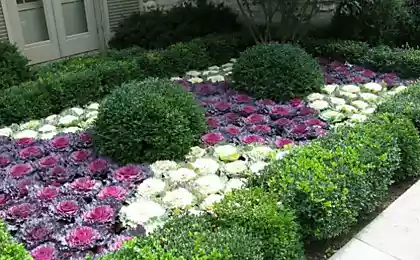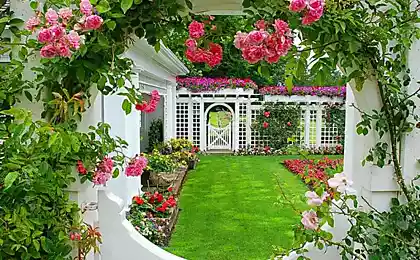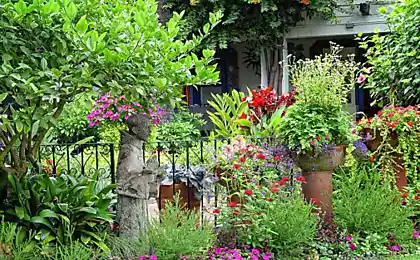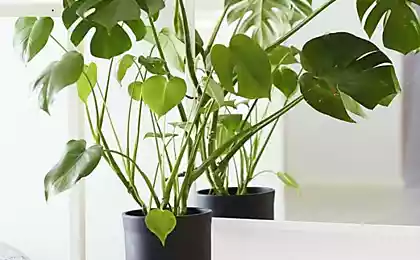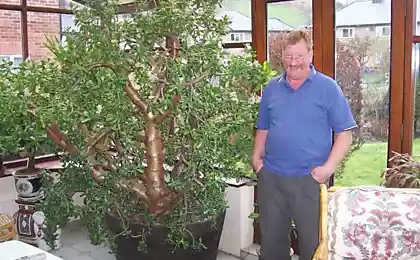418
The dream of summer residents is a garden that grows on its own
The dream of many summer residents is a garden that grows and blooms “by itself”, without requiring care, without any care with fertilizing, pruning, watering. And the point is not that we are lazy - just time is not enough, and you want to work hard at the country, but also relax, gain strength. Well, let's try to create a "lazy" garden - as they say, "planted and forgot." And then you wonder how beautiful it is.
In fact, we need to solve 2 problems: choose the right plants and successfully plant them. This means, first of all, taking into account the requirements of the plant itself and the peculiarities of the territory we can provide it; combining only those flowers that prefer the same or similar conditions. It is clear that by planting, for example, a shady plant in the sun, we condemn it to death, even if it is such a tenacious and undemanding garden dweller as a host.
As for the choice, of course, preference should be given to unpretentious and undemanding creatures of nature and breeders. There are many. 27 unpretentious flowers for beginner gardeners, we have already considered in detail (and this list, I note, may interest not only beginners). This time we will add a bit to the list and talk in more detail about how to organize a garden that will remain well-groomed and beautiful almost without the participation of its owner. Our task is to create conditions and not to interfere)
Few things poison the summer life of a summer resident more than weeding. We have already discussed in detail 9 ways to combat weeds, but I want this problem to not be. Therefore, in the “lazy” garden weeds will simply be eliminated. How? Here's how.
1. Weed, as we know, appears where there is free land. No her, no weeds. Mulch, ground cover plants, dense, dense plantings - all this leaves our enemy not the slightest chance.
However, one should not hope that everything will turn out by itself, "by pike order, according to my desire." In the first year you will have to make some effort. First, the soil is well prepared, try to remove the rhizomes of perennial herbs, so that they do not disturb later. Secondly, while planted plants are still very small, help them in the fight against weeds.
Here mulch is very useful to us - it will decorate the flower bed, and moisture in the soil will help (which will save us from watering), and fight with weeds. Soil protectors will also help, but do not plant them under those plants that you plan to shelter for the winter - under the cover of many soil cover.
2. Some types of quite aggressive wild herbs can serve us well: do not cut them out, but on the contrary, cultivate them. Veronica is oak, the cuff is soft, the buddy is ivy-shaped, the erect-roofed lapchatka - these and many other herbs will decorate your garden, displacing weeds, but not interfering with cultivated plants. Besides, they're all medicinal.
Dikorossy constantly settles in my garden. Sometimes, cultivating another piece of land, I do not fall them mercilessly, but transplant them into flower beds. So under the young kalina settled veronica, and under the spirea - budrum ivy; cuff is the company of the hosts, and juicy leaves plantain "work" curb :)
The snail crawls - and is a full member of many flower compositions, and, both varietal and wild - from the nearest lawn. In the spring, they bloom beautifully, and then hide in the shadow of their cultural partners. Competitors, such as the swan and the lice, are simply being pushed out.
Creating a “lazy” garden, it is important to follow the hints of nature as closely as possible, so the ideal for the implementation of such an idea will be a landscape, natural style. Options in the rural style (country) are also possible, but the classics will have to be abandoned: strict forms and ordered lines are not combined with our idea of a garden that does not require care.
If you want to break a rocky garden, also give preference to the rocarya, as if repeating the outlines of natural rock scum or other natural landscape. Attractive Japanese stone gardens and other stylish “oriental delights”, like the classic alpinarium, will require careful care and regular attention.
It all depends on the conditions, however banal, but it is true. If the plot you got low, wet, swampy - plant moisture-loving plants. In the sun, place heat lovers, and on sandy or stony soils - those flowers that grow in nature on dry rocky areas. If you fulfill this (not so difficult, agree!) condition, flower beds will require minimal care - because the plants fall into the familiar environment, where they are able to take care of themselves.
A very simple example that illustrates this idea. Astilba and Brunnera are two exceptionally unpretentious plants that can grow and bloom magnificently without any care at all. There is only one “but”: they need penumbra and moisture in abundance. And if I can provide them with the first, then the second on our sandy soils can be difficult. And I understand that it will not be possible to do without care here - either water in dry weather, or refuse to grow these plants.
When creating a garden, we want to admire it from early spring to late autumn, right? So, choosing plants, it is worth taking care that they reach the peak of their beauty not at the same time, but alternately. They also hide each other’s weaknesses (if any).
For example, all growers know: small bulbs are good in early spring, as soon as the snow falls, but by the end of May they lose their attractiveness. And the truth is, what can be beautiful in dried foliage... But you can't cut it before the deadline. Then we have to disguise! Hosts, astilbs, aquilegia, cuff - a lot of unpretentious plants will perfectly cope with this task.
In general, plants with decorative foliage in the “lazy” garden are simply indispensable! And if the conditions allow you to plant unpretentious conifers, then the beauty will remain in winter. Do not forget also about cereals: they place accents, and their quivering in the wind spikelets animate the landscape.
In the article Blooms of continuous flowering: unfading garden decoration, we talked in detail about how to pick up and place plants in the flower garden so that they please the eye all season. Many recommendations from this material will be useful when creating a “lazy” garden.
Plants for lazy people So, what do we plant in our “lazy” garden, which then does not require our tireless attention and constant care? Once again, I remind you of the link to the article about unpretentious flowers - there you will find a detailed description of bulbous, beautifully flowering perennials and the easiest to grow and care for annual and biennial plants, each of which is quite suitable for our purpose. We will not repeat ourselves, remember those plants that were not mentioned in that material – unpretentious soil cover and decorative-leaf cultures.
Soil cover plants are absolutely indispensable where you need to quickly occupy empty spaces. But many of them are good in themselves, so they can be used as full members of the composition. It is only important to keep in mind: most soil coverants are aggressive, grow well and take up a lot of space. Even in a “lazy” garden, which involves free planning, such activity is not always appropriate.
Chittings
These are amazing and very diverse plants, about which you can not say in two words. A separate conversation about them will certainly take place, but for now I will recall only some nuances.
The kingdom of chicks includes species with diverse requirements for conditions: there are only drought-tolerant specimens, but some require moisture; most grow well on poor soils, but there are also those who need good nutrition. Therefore, when choosing stones for your garden, it is always important to inquire about the requirements of a particular plant.
All of them grow, but everything is different. Among the record holders are the false squirrels and the caustic squirrels, which grow rapidly. I, for example, love to “settle” to low shrubs, at the foot of which he creates a solid “rug”. As a “living mulch”, it spreads under roses (where, unlike the white finish, it does not prevail in the cold season).
Many stones bloom beautifully, and at the time of flowering attract bees. Combining different types and varieties, you can create beautiful compositions even from scratch marks alone. Read more about these plants and their use in the garden in our publications: My squirrel collection and Pink Round.
Stonebreakers
Like stones, stonebreaks are quite diverse - the genus includes 440 species, many of which have healing properties.
Most stone breakers are especially decorative at the time of flowering, when numerous buds of white or pink flowers open above them on high peduncles.
Plants are completely undemanding, reproduce well and grow quickly (but for the most part are not aggressive). You can grow from seeds, but vegetative reproduction (division, daughter sockets) is faster, easier and more efficient.
Penumbra is generally preferred; most species grow well on poor, dry soils rich in calcium. The best stone breakers will look in rockariums and stony gardens, on dry retaining walls.
Snail crawling.
This plant (including its varieties, which are distinguished by an amazing color of the foliage) is readily used by gardeners to create perennial curbs in flower gardens. Appropriate survivor and under bushes, and in rockariums. In May, it blooms, delighting with bright blue “spikelets”-inflorescences on high flower-bearers.
It grows very actively due to creeping lateral shoots, on which numerous rooted outlets are formed. Variety plants may not be as aggressive, grow more moderately and sometimes are more demanding to conditions than a wild-growing counterpart.
You can read more about this plant in the article Forest and field plants in the garden: the sliver is creeping, and about what surprises it hides, the post Autumn transformation of the creeping sliver will tell.
Veronica is filamentous
The thawing "grass" forms dense carpets, in May-June completely strewn with small white-blue flowers. The beauty is indescribable! Weeds suppress (although some persistent species break through, but they are easier to cope with, because these are single plants), and if you plant veronica on treated soil, then weeding in this place can be forgotten.
But aggressive is not a joke: the increase gives a very large, spreads extremely actively. Relatively short-lived: after 2-3 years "leaves" from the original place, and you need to resume planting (good, it is easy: take a piece of young growth, put on loose soil, slightly pressed, abundantly watered - everything!).
It is best to plant filamentous veronica under shrubs or large perennials - instead of mulch. So, I have her thriving under the old peony, I put her in a young cherry. But from the lawns should keep this grass away...
Decoratively deciduous plants with decorative foliage are always popular with gardeners. The garden will be decorated even when there are few flowers in it. Decorativeness can consist both in coloring and in the form of leaves, and a variety of plants are included in this group. Just a few of them.
hosta
This plant probably does not need a special representation - it has long won the hearts of our gardeners. It is described in detail in Host’s article – “Queen of the Shadow”, and the nuances of landing are presented in the step-by-step photo instruction Step by step: select and plant a host.
In the shady and semishady corners of the garden, the host does not need care, and if the soil on the site is sufficiently moist, then even a severe drought this plant will survive without a single irrigation. However, it is necessary to take into account the characteristics of varieties, which modern selection has generated a huge number. So, hosts with delicate light leaves are often sensitive to sunburn, and ugly yellow spots may appear on the leaves of blue hosts from moisture.
The main enemy of the host is slugs (there are varieties that this pest bypasses), but coarse mulch helps from them (for example, from the bark of wood). Hosts are harmoniously combined with many garden plants; you can use them for planting under trees, and along the edge of bushes; compact species form a chic curb, and “large-sized” are able to perform with a “solar party”.
Cuff
Don’t be surprised to hear the mention of this weed plant in such a “company.” I was surprised to read that European gardeners, for example, appreciate this plant and willingly cultivate it. Take a closer look at our wild cuff. Yes, she deserves to settle in the garden! In "lazy" - exactly :) Forest and field plants in the garden: cuff
I will only add that you can take care of the search for varietal plants, or you can just plant an ordinary wild cuff in favorable conditions - it will surprise and certainly please you. Do not forget about the healing properties of this modesty. The only drawback: the wild cuff grows well and can take up quite large spaces. If the garden area allows - safely plant it among the bushes, settle in extensive mixboarders to tall perennials.
Meduna
A charming spring primrose, the honeycomb wakes up in the garden one of the first. But having completed flowering, it will attract attention with its colorful foliage.
The flowering period of the honeycomb is quite short, and the flowers that surprise with the change of color are very modest, so it is logical to attribute it to decorative and leafy plants. About varieties of honeycomb, its healing properties, cultivation and use in the garden you can learn in detail from the article Medunica-fashioner or lung grass.
Byzantine cleaner
Fans of unusual textures and colors of foliage will certainly appreciate this plant, nicknamed “sheep ears”. In fact, covered with silky hairs silvery leaves of the cleaner resemble long ears, which you want to stroke) Read more about this plant in the article “Sheep’s ears” on the flowerbed.
The cleaner can be used as a curb, and you can allow it to grow freely among other plants in the flower garden - it will unobtrusively shade them with its foliage. The only thing you can do for him for the whole season is to cut off the flower-noses if you want the cleaner to grow luxuriant. If you don’t, he won’t be offended.
Of course, the submitted list everyone is free to continue at their discretion. We did not say a word about unpretentious shrubs, nor did we mention many perennials. I would be glad if you add your favorite plants in the comments.
Unpretentious and beautiful flowers are much more than we used to think. Having created comfortable conditions for them, we save ourselves from many worries and can devote time to rest and contemplation of the man-made beauty of our garden.
Source: www.7dach.ru
In fact, we need to solve 2 problems: choose the right plants and successfully plant them. This means, first of all, taking into account the requirements of the plant itself and the peculiarities of the territory we can provide it; combining only those flowers that prefer the same or similar conditions. It is clear that by planting, for example, a shady plant in the sun, we condemn it to death, even if it is such a tenacious and undemanding garden dweller as a host.
As for the choice, of course, preference should be given to unpretentious and undemanding creatures of nature and breeders. There are many. 27 unpretentious flowers for beginner gardeners, we have already considered in detail (and this list, I note, may interest not only beginners). This time we will add a bit to the list and talk in more detail about how to organize a garden that will remain well-groomed and beautiful almost without the participation of its owner. Our task is to create conditions and not to interfere)
Few things poison the summer life of a summer resident more than weeding. We have already discussed in detail 9 ways to combat weeds, but I want this problem to not be. Therefore, in the “lazy” garden weeds will simply be eliminated. How? Here's how.
1. Weed, as we know, appears where there is free land. No her, no weeds. Mulch, ground cover plants, dense, dense plantings - all this leaves our enemy not the slightest chance.
However, one should not hope that everything will turn out by itself, "by pike order, according to my desire." In the first year you will have to make some effort. First, the soil is well prepared, try to remove the rhizomes of perennial herbs, so that they do not disturb later. Secondly, while planted plants are still very small, help them in the fight against weeds.
Here mulch is very useful to us - it will decorate the flower bed, and moisture in the soil will help (which will save us from watering), and fight with weeds. Soil protectors will also help, but do not plant them under those plants that you plan to shelter for the winter - under the cover of many soil cover.
2. Some types of quite aggressive wild herbs can serve us well: do not cut them out, but on the contrary, cultivate them. Veronica is oak, the cuff is soft, the buddy is ivy-shaped, the erect-roofed lapchatka - these and many other herbs will decorate your garden, displacing weeds, but not interfering with cultivated plants. Besides, they're all medicinal.
Dikorossy constantly settles in my garden. Sometimes, cultivating another piece of land, I do not fall them mercilessly, but transplant them into flower beds. So under the young kalina settled veronica, and under the spirea - budrum ivy; cuff is the company of the hosts, and juicy leaves plantain "work" curb :)
The snail crawls - and is a full member of many flower compositions, and, both varietal and wild - from the nearest lawn. In the spring, they bloom beautifully, and then hide in the shadow of their cultural partners. Competitors, such as the swan and the lice, are simply being pushed out.
Creating a “lazy” garden, it is important to follow the hints of nature as closely as possible, so the ideal for the implementation of such an idea will be a landscape, natural style. Options in the rural style (country) are also possible, but the classics will have to be abandoned: strict forms and ordered lines are not combined with our idea of a garden that does not require care.
If you want to break a rocky garden, also give preference to the rocarya, as if repeating the outlines of natural rock scum or other natural landscape. Attractive Japanese stone gardens and other stylish “oriental delights”, like the classic alpinarium, will require careful care and regular attention.
It all depends on the conditions, however banal, but it is true. If the plot you got low, wet, swampy - plant moisture-loving plants. In the sun, place heat lovers, and on sandy or stony soils - those flowers that grow in nature on dry rocky areas. If you fulfill this (not so difficult, agree!) condition, flower beds will require minimal care - because the plants fall into the familiar environment, where they are able to take care of themselves.
A very simple example that illustrates this idea. Astilba and Brunnera are two exceptionally unpretentious plants that can grow and bloom magnificently without any care at all. There is only one “but”: they need penumbra and moisture in abundance. And if I can provide them with the first, then the second on our sandy soils can be difficult. And I understand that it will not be possible to do without care here - either water in dry weather, or refuse to grow these plants.
When creating a garden, we want to admire it from early spring to late autumn, right? So, choosing plants, it is worth taking care that they reach the peak of their beauty not at the same time, but alternately. They also hide each other’s weaknesses (if any).
For example, all growers know: small bulbs are good in early spring, as soon as the snow falls, but by the end of May they lose their attractiveness. And the truth is, what can be beautiful in dried foliage... But you can't cut it before the deadline. Then we have to disguise! Hosts, astilbs, aquilegia, cuff - a lot of unpretentious plants will perfectly cope with this task.
In general, plants with decorative foliage in the “lazy” garden are simply indispensable! And if the conditions allow you to plant unpretentious conifers, then the beauty will remain in winter. Do not forget also about cereals: they place accents, and their quivering in the wind spikelets animate the landscape.
In the article Blooms of continuous flowering: unfading garden decoration, we talked in detail about how to pick up and place plants in the flower garden so that they please the eye all season. Many recommendations from this material will be useful when creating a “lazy” garden.
Plants for lazy people So, what do we plant in our “lazy” garden, which then does not require our tireless attention and constant care? Once again, I remind you of the link to the article about unpretentious flowers - there you will find a detailed description of bulbous, beautifully flowering perennials and the easiest to grow and care for annual and biennial plants, each of which is quite suitable for our purpose. We will not repeat ourselves, remember those plants that were not mentioned in that material – unpretentious soil cover and decorative-leaf cultures.
Soil cover plants are absolutely indispensable where you need to quickly occupy empty spaces. But many of them are good in themselves, so they can be used as full members of the composition. It is only important to keep in mind: most soil coverants are aggressive, grow well and take up a lot of space. Even in a “lazy” garden, which involves free planning, such activity is not always appropriate.
Chittings
These are amazing and very diverse plants, about which you can not say in two words. A separate conversation about them will certainly take place, but for now I will recall only some nuances.
The kingdom of chicks includes species with diverse requirements for conditions: there are only drought-tolerant specimens, but some require moisture; most grow well on poor soils, but there are also those who need good nutrition. Therefore, when choosing stones for your garden, it is always important to inquire about the requirements of a particular plant.
All of them grow, but everything is different. Among the record holders are the false squirrels and the caustic squirrels, which grow rapidly. I, for example, love to “settle” to low shrubs, at the foot of which he creates a solid “rug”. As a “living mulch”, it spreads under roses (where, unlike the white finish, it does not prevail in the cold season).
Many stones bloom beautifully, and at the time of flowering attract bees. Combining different types and varieties, you can create beautiful compositions even from scratch marks alone. Read more about these plants and their use in the garden in our publications: My squirrel collection and Pink Round.
Stonebreakers
Like stones, stonebreaks are quite diverse - the genus includes 440 species, many of which have healing properties.
Most stone breakers are especially decorative at the time of flowering, when numerous buds of white or pink flowers open above them on high peduncles.
Plants are completely undemanding, reproduce well and grow quickly (but for the most part are not aggressive). You can grow from seeds, but vegetative reproduction (division, daughter sockets) is faster, easier and more efficient.
Penumbra is generally preferred; most species grow well on poor, dry soils rich in calcium. The best stone breakers will look in rockariums and stony gardens, on dry retaining walls.
Snail crawling.
This plant (including its varieties, which are distinguished by an amazing color of the foliage) is readily used by gardeners to create perennial curbs in flower gardens. Appropriate survivor and under bushes, and in rockariums. In May, it blooms, delighting with bright blue “spikelets”-inflorescences on high flower-bearers.
It grows very actively due to creeping lateral shoots, on which numerous rooted outlets are formed. Variety plants may not be as aggressive, grow more moderately and sometimes are more demanding to conditions than a wild-growing counterpart.
You can read more about this plant in the article Forest and field plants in the garden: the sliver is creeping, and about what surprises it hides, the post Autumn transformation of the creeping sliver will tell.
Veronica is filamentous
The thawing "grass" forms dense carpets, in May-June completely strewn with small white-blue flowers. The beauty is indescribable! Weeds suppress (although some persistent species break through, but they are easier to cope with, because these are single plants), and if you plant veronica on treated soil, then weeding in this place can be forgotten.
But aggressive is not a joke: the increase gives a very large, spreads extremely actively. Relatively short-lived: after 2-3 years "leaves" from the original place, and you need to resume planting (good, it is easy: take a piece of young growth, put on loose soil, slightly pressed, abundantly watered - everything!).
It is best to plant filamentous veronica under shrubs or large perennials - instead of mulch. So, I have her thriving under the old peony, I put her in a young cherry. But from the lawns should keep this grass away...
Decoratively deciduous plants with decorative foliage are always popular with gardeners. The garden will be decorated even when there are few flowers in it. Decorativeness can consist both in coloring and in the form of leaves, and a variety of plants are included in this group. Just a few of them.
hosta
This plant probably does not need a special representation - it has long won the hearts of our gardeners. It is described in detail in Host’s article – “Queen of the Shadow”, and the nuances of landing are presented in the step-by-step photo instruction Step by step: select and plant a host.
In the shady and semishady corners of the garden, the host does not need care, and if the soil on the site is sufficiently moist, then even a severe drought this plant will survive without a single irrigation. However, it is necessary to take into account the characteristics of varieties, which modern selection has generated a huge number. So, hosts with delicate light leaves are often sensitive to sunburn, and ugly yellow spots may appear on the leaves of blue hosts from moisture.
The main enemy of the host is slugs (there are varieties that this pest bypasses), but coarse mulch helps from them (for example, from the bark of wood). Hosts are harmoniously combined with many garden plants; you can use them for planting under trees, and along the edge of bushes; compact species form a chic curb, and “large-sized” are able to perform with a “solar party”.
Cuff
Don’t be surprised to hear the mention of this weed plant in such a “company.” I was surprised to read that European gardeners, for example, appreciate this plant and willingly cultivate it. Take a closer look at our wild cuff. Yes, she deserves to settle in the garden! In "lazy" - exactly :) Forest and field plants in the garden: cuff
I will only add that you can take care of the search for varietal plants, or you can just plant an ordinary wild cuff in favorable conditions - it will surprise and certainly please you. Do not forget about the healing properties of this modesty. The only drawback: the wild cuff grows well and can take up quite large spaces. If the garden area allows - safely plant it among the bushes, settle in extensive mixboarders to tall perennials.
Meduna
A charming spring primrose, the honeycomb wakes up in the garden one of the first. But having completed flowering, it will attract attention with its colorful foliage.
The flowering period of the honeycomb is quite short, and the flowers that surprise with the change of color are very modest, so it is logical to attribute it to decorative and leafy plants. About varieties of honeycomb, its healing properties, cultivation and use in the garden you can learn in detail from the article Medunica-fashioner or lung grass.
Byzantine cleaner
Fans of unusual textures and colors of foliage will certainly appreciate this plant, nicknamed “sheep ears”. In fact, covered with silky hairs silvery leaves of the cleaner resemble long ears, which you want to stroke) Read more about this plant in the article “Sheep’s ears” on the flowerbed.
The cleaner can be used as a curb, and you can allow it to grow freely among other plants in the flower garden - it will unobtrusively shade them with its foliage. The only thing you can do for him for the whole season is to cut off the flower-noses if you want the cleaner to grow luxuriant. If you don’t, he won’t be offended.
Of course, the submitted list everyone is free to continue at their discretion. We did not say a word about unpretentious shrubs, nor did we mention many perennials. I would be glad if you add your favorite plants in the comments.
Unpretentious and beautiful flowers are much more than we used to think. Having created comfortable conditions for them, we save ourselves from many worries and can devote time to rest and contemplation of the man-made beauty of our garden.
Source: www.7dach.ru
Enel begins construction of 100 MW solar power plant in Chile
How to drink water. Water balance in the body





